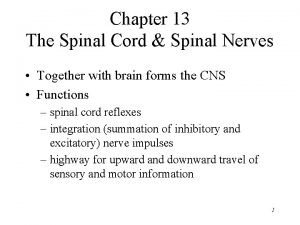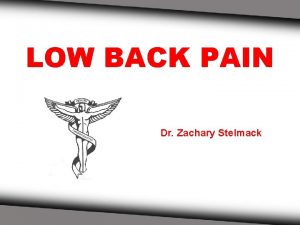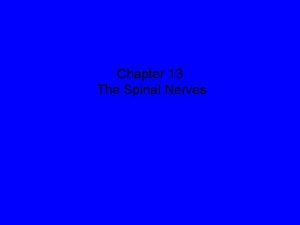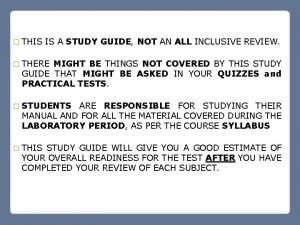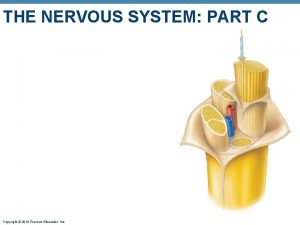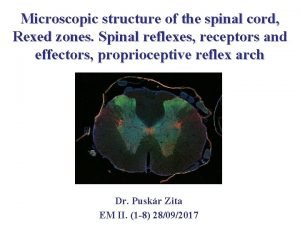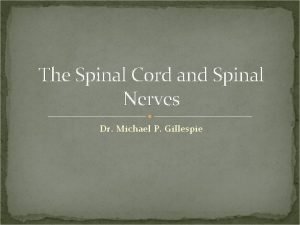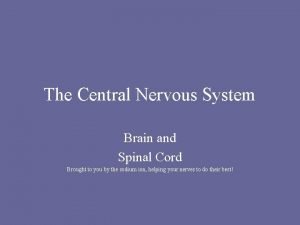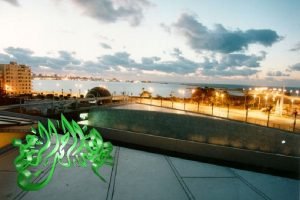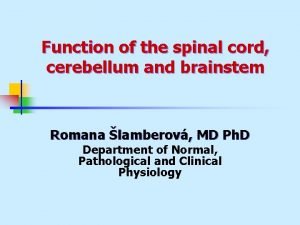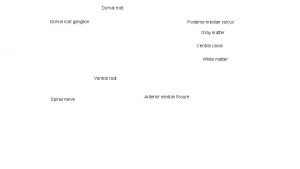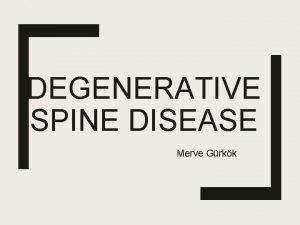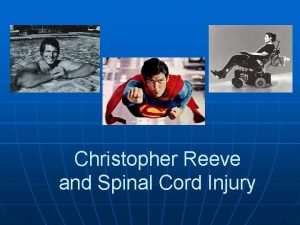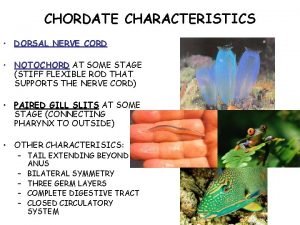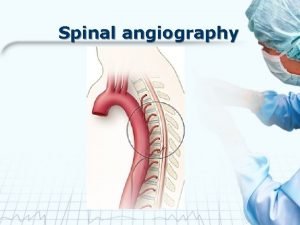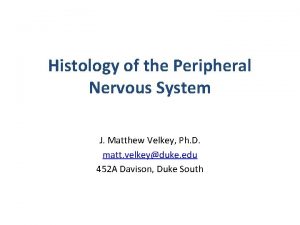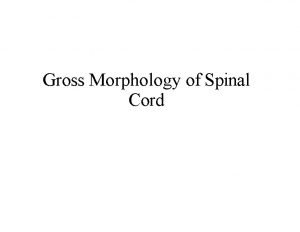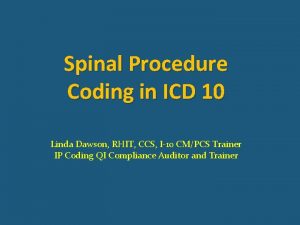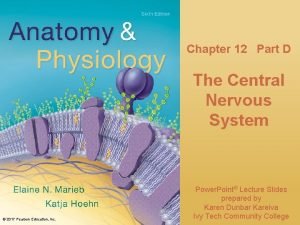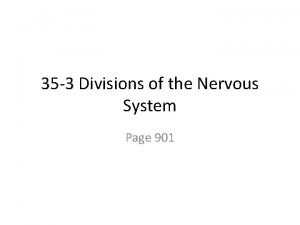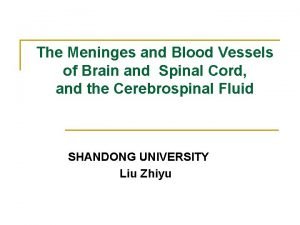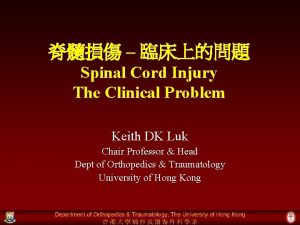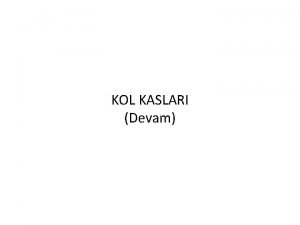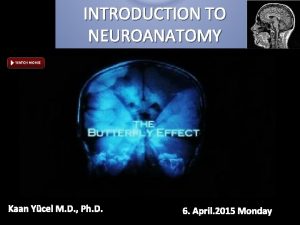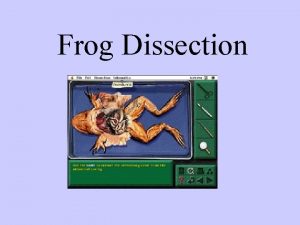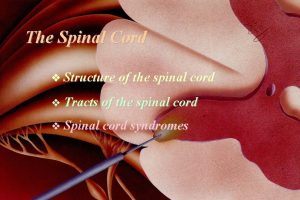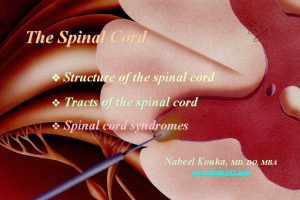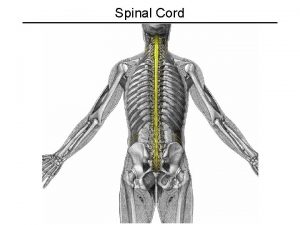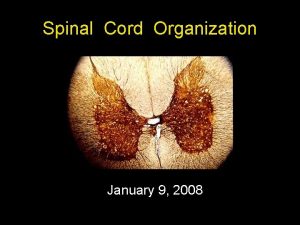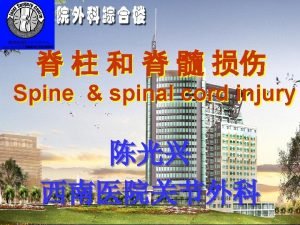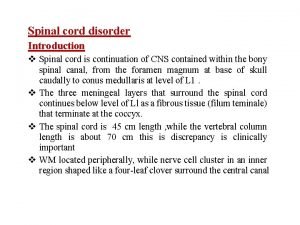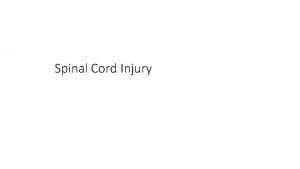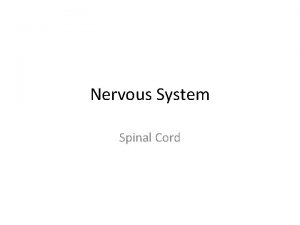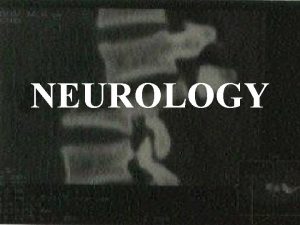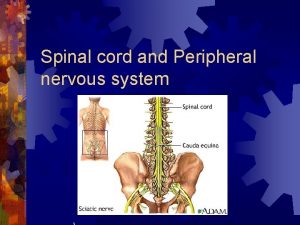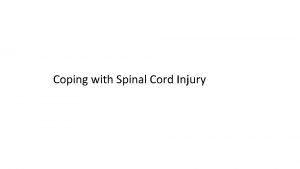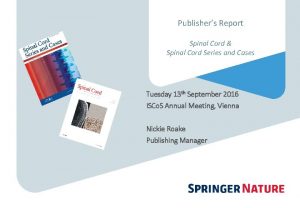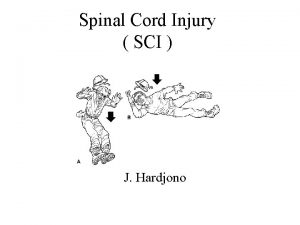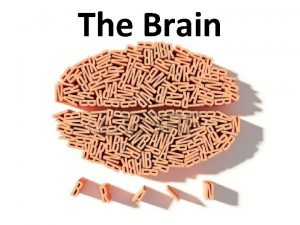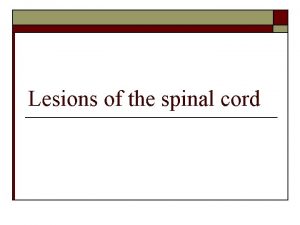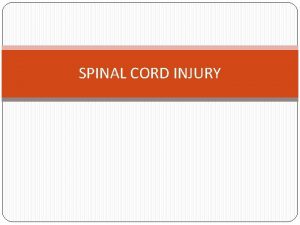Anatomy of the Spinal Cord Structure of the












































- Slides: 44

Anatomy of the Spinal Cord Structure of the spinal cord v Tracts of the spinal cord v Spinal cord syndromes

Spinal Cord - Comparable to Input-Output (IO) System of the Computer - Spinal Nerve (C 8, T 12, L 5, S 5, Cx 1) - Segmental Structure of Neural Tube Origin

Spinal segment C 8, T 12, L 5, S 5, Cx 1 Anterior (Ventral) Root Posterior (Dorsal) Root Dorsal Root (Spinal) Ganglion Root - Rootlets

Spinal Cord External Figure Conus Medullaris (L 1 -2) Spinomedullary Junction - Foramen Magnum, Pyramidal decussation, C 1 ventral root Enlargements - cervical (C 5 -T 1) & lumbosacral (L 1 -L 4) Longitudinal Fissures - anterior median fissure - anterolateral fissure - posterior median sulcus - posterolateral sulcus

Conus Medullaris (L 1 -2) Cauda Equina Anterior median fissure Anterolateral fissure

Posterior median sulcus Posterolateral sulcus Posterior intermediate sulcus Fasciculus cuneatus Fasciculus gracilis Posterior surface of the spinal cord

Spinal Cord Meninges Periosteum of Vertebra - Epidural Space --------- epidural anesthesia Dura Mater Spinalis Arachnoid Membrane - Subarachnoid Space ---- Lumbar Puncture Spinal Anesthesia Pia Mater Spinalis - Denticulate Ligament ----- Cordotomy - Filum Terminale

Meninges of the spinal cord • Dura mater • Arachnoid membrane • Pia mater Denticulate ligament - specilization of the pia mater - landmark for cordotomy

Meninges of the spinal cord

Meninges of the spinal cord

Lumbar Puncture – lumbar (terminal) cistern

Spinal Cord Vascular Supply Arterial Supply - Spinal Arteries Anterior (1) & Posterior (2) Spinal Artery from Vertebral artery - Radicular Arteries ----- Segmental arteries from Vertebral, Ascending Cervical, Intercostal and Lumbar Artery Venous Drainage - Longitudinal & Radicular Veins to Intervertebral veins ---- to Internal Vertebral Venous Plexus to external vertebral venous plexus ---- to segmental veins

5. Adamkiwicz artery anterior spinal artery segmental arteries

Spinal Cord Internal Structure White Matter Anterior Funiculus (Anterior White Column) Posterior Funiculus (Posterior White Column) Fasciculus Gracilis & Fasciculus Cuneatus Lateral Funiculus (Lateral White Column) Gray Matter Anterior Horn ------ --Posterior Horn -------Lateral Horn --------Gray Commissure ---- motor sensory autonomic (sympathetic) anterior and posterior

• Resembles a butterfly. • 2 lateral gray masses connected by the gray commissure. • Posterior projections are the posterior or dorsal horns. • Anterior projections are the anterior or ventral horns. • In the thoracic and lumbar cord, there also exist lateral horns.

Gray Matter • Posterior horns contain interneurons. • Anterior horns contain some interneurons as well as the cell bodies of motor neurons. – These cell bodies project their axons via the ventral roots of the spinal cord to the skeletal muscles. – The amount of ventral gray matter at a given level of the spinal cord is proportional to the amount of skeletal muscle innervated.

Gray Matter • Lateral horn neurons are sympathetic motor neurons serving visceral organs. – Their axons also exit via the ventral root. • Afferent sensory fibers carrying info from peripheral receptors form the dorsal roots of the spinal cord. The somata of these sensory fibers are found in an enlargement known as a dorsal root ganglion. • The dorsal and ventral roots fuse to form spinal nerves.

1. posterior horn 2. anterior horn 3. intermediate zone (intermediate gray) 4. lateral horn 5. posterior funiculus 6. anterior funiculus 7. lateral funiculus 8. Lissauer's tract 9. anterior median fissure 10. posterior median sulcus 11. anterolateral sulcus 12. posterolateral sulcus 13. Posterior intermediate sulcus

cervical enlargement (C 8) lumbal enlargement (L 3) thoracic cord (T 8) sacral cord (S 1)


Spinal Cord Internal Structure Principles of Cord Organization 1) Longitudinal Arrangement Fibers (White Matter) ------- White Column Cell Groups (Gray Matter) ------- Gray Column 2) Transverse Arrangement Afferent & Efferent Fibers Crossing (Commissural and Decussating) Fibers 3) Somatotopical Arrangement

Columnnar arrangement somatotopical arrangement

Spinal Cord Internal Structure Laminae of Rexed Lamina I ----- posteromarginal nucleus Lamina II ----- substantia gelatinosa of Rolando Lamina III, IV ----- nucleus proprius Lamina V, VI Lamina VII ----- intermediate gray intermediolateral cell column (ILM) Clarke’s column (Nucleus dorsalis) intermediomedial cell column (IMM) Lamina VIII Lamina IX ----- anterior horn (motor) cell Lamina X ------ gray commissure

Laminae of Rexed

White Matter • Myelinated nerve fibers. • Allows for communication btwn the brain and spinal cord or btwn different regions of the spinal cord. • White matter on each side of the cord is divided into columns or funiculi. – Typically, they are ascending or descending. » What does that mean?

Spinal Cord Tracts Ascending Tracts Modality: Touch, Pain, Temperature, Kinesthesia Receptor: Exteroceptor, Interoceptor, Proprioceptor Primary Neuron: Dorsal Root Ganglion (Spinal Ganglion) Secondary Neuron: Spinal Cord or Brain Stem (Tertiary Neuron): Thalamus (Ventrobasal Nuclear Complex) Termination: Cerebral Cortex, Cerebellar Cortex, or Brain Stem

Spinal Cord Tracts Ascending Tracts Posterior White Column-Medial Lemniscal Pathway Spinothalamic Tract Spinoreticular or Spinoreticulothalamic Tract Spinocerebellar Tract Spinomedullothalamic Tract Cervicothalamic or Spinocervicothalamic Tract Spino-olivary Tract Spinotectal Tract

medial lemniscus lemniscal decussation internal arcuate fiber posterior white column posterior root Posterior White Column Medial Lemniscal Pathway - ipsilateral loss of discriminative touch sensation and conscious proprioception below the level of lesion

spinothalamic tract decussation anterior white commissure posterior root Spinothalamic Tract - contralateral loss of pain and temperature sensation below the level of lesion

Descending tracts Lateral pathway -Voluntary movement of distal muscles -Direct cortical control Ventromedial pathway -Pose and antigravitational movements -Indirect cortical (stem) control

Corona Radiata lnternal Capsule, Posterior Limb Crus Cerebri, Middle Portion Longitudinal Pontine Fiber Pyramid CR Pyramidal Decussation Corticospinal Tract IC - Lateral and Anterior LPF Corticospinal Tract Pyr - ipsilateral UMN syndrome at the level of lesion PD ACST LCST

Spinal Cord Tracts Descending Tracts from Brain Stem ventromedial pathway dorolateral pathway

Spinal Nerves • 31 nerves connecting the spinal cord and various body regions. » » » 8 paired cervical nerves 12 paired thoracic nerves 5 paired lumbar nerves 5 paired sacral nerves 1 pair of coccygeal nerves

Spinal Nerves • Each connects to the spinal cord by 2 roots – dorsal and ventral. • Each root forms from a series of rootlets that attach along the whole length of the spinal cord segment. • Ventral roots are motor while dorsal roots are sensory.

Spinal Nerves • The 2 roots join to form a spinal nerve prior to exiting the vertebral column. • Roots are short and horizontal in the cervical and thoracic regions while they are longer and more horizontal in the sacral and lumbar regions. • After emerging from its intervertebral foramen, a spinal nerve divides into • dorsal ramus, • ventral ramus, and • meningeal branch that recurs to supply the meninges and associated blood vessels.

• Each ramus is mixed. • Joined to the base of the ventral rami of spinal nerves in the thoracic region are the rami communicantes. These are sympathetic fibers that we’ll deal with shortly. • Dorsal rami supply the posterior body trunk whereas the thicker ventral rami supply the rest of the body trunk and the limbs.

Reflex Arcs • A reflex is a rapid, predictable motor response to a stimulus. Unlearned and involuntary. • Example? • Components of a reflex arc: – Receptor site of stimulus – Sensory neuron transmits afferent info to CNS – Integration center 1 or more interneurons – Motor neuron transmits efferent signals to effector – Effector muscle or gland

Reflexes • Reflexes involving skeletal muscles and somatic motor neurons are somatic. • Reflexes controlled by autonomic neurons are autonomic. • Spinal reflexes are integrated w/i the spinal cord while cranial reflexes are integrated in the brain. • Reflexes may be inborn or learned. • Reflexes may be monosynaptic or polysynaptic. – Difference?


Spinal Cord Syndrome Predominantly Motor Syndromes • Poliomyelitis (Infantile Paralysis) - viral infection of lower motor neuron - LMN syndrome at the level of lesion • Amyotrophic Lateral Sclerosis (ALS) - combined LMN and UMN lesion - LMN syndrome at the level of lesion - UMN syndrome below the level of lesion - Lou Gehrig’s disease in USA

Spinal Cord Syndrome 1. corticospinal tract 2. lower motor neuron (LMN) Amyotrophic Lateral Sclerosis

Spinal Cord Syndrome Amyotrophic Lateral Sclerosis (ALS) Lou Gherig’s Disease Stephen Haking (1946 - ) British Physicist, A Brif History of Time

Spinal Cord Syndrome Brown-Sequard syndrome (spinal cord hemisection) Major Symptoms 1. ipsilateral UMN syndrome below the level of lesion 2. ipsilateral LMN syndrome at the level of lesion 3. ipsilateral loss of discriminative touch sensation and conscious proprioception below the level of lesion (posterior white column lesion) 4. contralateral loss of pain and temperature sensation below the level of lesion (spinothalamic tract lesion)

Spinal Cord Syndrome Brown-Sequard Syndrome (Spinal Cord Hemisection)
 Spinal nerves labled
Spinal nerves labled Spinal cord and spinal meninges
Spinal cord and spinal meninges Lateral pectoral nerve
Lateral pectoral nerve Rubrospinal
Rubrospinal Spinal cord covered by
Spinal cord covered by Back hurts
Back hurts Spinal cord nerve anatomy
Spinal cord nerve anatomy Grey commissure
Grey commissure Spinal cord diagram
Spinal cord diagram Lumbosacral enlargement
Lumbosacral enlargement Spinal cord diagram
Spinal cord diagram Spinal cord structure
Spinal cord structure Medulla spinalis
Medulla spinalis Spinal cord denticulate ligament
Spinal cord denticulate ligament Nervous sysytem
Nervous sysytem Hyporeflexia and hyperreflexia
Hyporeflexia and hyperreflexia Anterior ramus of spinal cord
Anterior ramus of spinal cord Site:slidetodoc.com
Site:slidetodoc.com Dorsal root
Dorsal root Intervertebral disc prolapse
Intervertebral disc prolapse Christopher reeve spinal cord injury level
Christopher reeve spinal cord injury level Dorsal nerve cord notochord
Dorsal nerve cord notochord Gray commissure of spinal cord
Gray commissure of spinal cord Vestibulospinal tract
Vestibulospinal tract Spinal cord
Spinal cord Tethered spinal cord
Tethered spinal cord Function of spinal cord ppt
Function of spinal cord ppt Spinal angiogram
Spinal angiogram Foramen costo transversarium
Foramen costo transversarium Mezgovnice
Mezgovnice Spinal cord
Spinal cord Spinal cord level
Spinal cord level Morphology of spinal cord
Morphology of spinal cord Diet for spinal cord injury patient
Diet for spinal cord injury patient Vertebroplasty icd 10 code
Vertebroplasty icd 10 code Intensivis
Intensivis Spinal cord cross section
Spinal cord cross section Spinal cord and brain
Spinal cord and brain Formation of csf
Formation of csf Christopher reeve ventilator
Christopher reeve ventilator Spinal cord injury shoulder exercises
Spinal cord injury shoulder exercises Subanconeus
Subanconeus Ventral root
Ventral root Animalia latin meaning
Animalia latin meaning Descending
Descending




